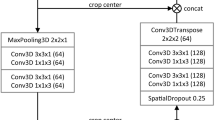Zusammenfassung
Fully automatic liver segmentation is important for the planning of liver interventions and decision support. In patients with HCC, dynamic-contrast enhanced MRI is particularly relevant. Previouswork has focused on liver segmentation in the late hepatobiliary contrast phase, which may not always be available in heterogeneous data from clinical routine. In this contribution, we demonstrate the training of a convolutional neural network across contrast phases of DCEMRI, that is on par with a specialized late-phase network (mean Dice score 0.96) but in addition is more robust to other contrast phase images compared with the specialized network.
Access this chapter
Tax calculation will be finalised at checkout
Purchases are for personal use only
Preview
Unable to display preview. Download preview PDF.
Similar content being viewed by others
Literatur
Bilic P et al. The liver tumor segmentation benchmark (LiTS). arXiv e-prints. 2019. arXiv:1901.04056.
Roberts LR, Sirlin CB, Zaiem F, Almasri J, Prokop LJ, Heimbach JK et al. Imaging for the diagnosis of hepatocellular carcinoma: a systematic review and meta-analysis. Hepatology. 2018;67(1):401–21.
Chlebus G, Schenk A. Automatic liver and tumor segmentation in late-phase MRI using fully convolutional neural networks. Procs CURAC. 2018:195–200.
Winther H, Hundt C, Ringe KI, Wacker FK, Schmidt B, Jürgens J et al. A 3D deep neural network for liver volumetry in 3T contrast-enhanced MRI. RoFo. 2021;193(3):305–14.
Strehlow J, Spahr N, Rühaak J, Laue H, Abolmaali N, Preusser T et al. Landmark-based evaluation of a deformable motion correction for DCE-MRI of the liver. Int J Comput Assist Radiol Surg. 2018;13(4):597–606.
Ronneberger O, Fischer P, Brox T. U-Net: convolutional networks for biomedical image segmentation. Lect Notes Comput Sci. 2015;9351:234–41.
Chlebus G, Schenk A, Hahn HK, Ginneken B van, Meine H. Robust segmentation models using an uncertainty slice sampling based annotation workflow. arXiv e-prints. 2021. arXiv:2109.14879.
Chollet F et al. Keras. https://keras.io. 2015.
Moltz JH, Hänsch A, Lassen-Schmidt B, Haas B, Genghi A, Schreier J et al. Learning a loss function for segmentation: a feasibility study. Procs ISBI. 2020:957–60.
Author information
Authors and Affiliations
Corresponding author
Editor information
Editors and Affiliations
Rights and permissions
Copyright information
© 2022 Der/die Autor(en), exklusiv lizenziert an Springer Fachmedien Wiesbaden GmbH, ein Teil von Springer Nature
About this paper
Cite this paper
Hänsch, A. et al. (2022). Robust Liver Segmentation with Deep Learning Across DCE-MRI Contrast Phases. In: Maier-Hein, K., Deserno, T.M., Handels, H., Maier, A., Palm, C., Tolxdorff, T. (eds) Bildverarbeitung für die Medizin 2022. Informatik aktuell. Springer Vieweg, Wiesbaden. https://doi.org/10.1007/978-3-658-36932-3_3
Download citation
DOI: https://doi.org/10.1007/978-3-658-36932-3_3
Published:
Publisher Name: Springer Vieweg, Wiesbaden
Print ISBN: 978-3-658-36931-6
Online ISBN: 978-3-658-36932-3
eBook Packages: Computer Science and Engineering (German Language)




